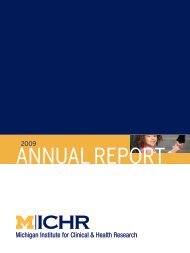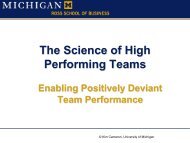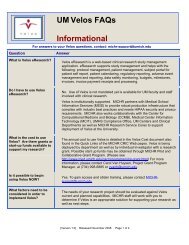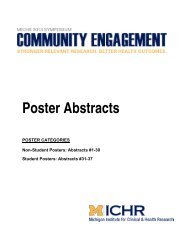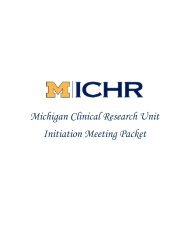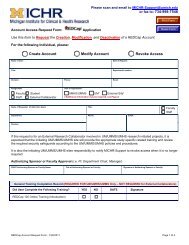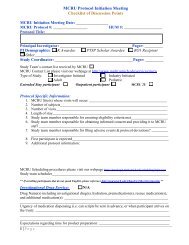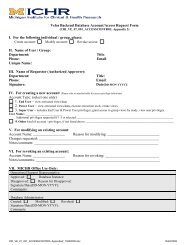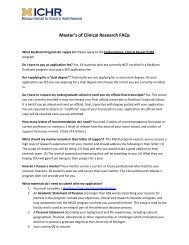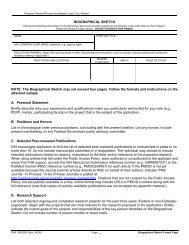Leading Team Science - Michigan Institute for Clinical & Health ...
Leading Team Science - Michigan Institute for Clinical & Health ...
Leading Team Science - Michigan Institute for Clinical & Health ...
Create successful ePaper yourself
Turn your PDF publications into a flip-book with our unique Google optimized e-Paper software.
LEADING TEAM SCIENCE:<br />
CONSIDERATIONS IN ORGANIZING,<br />
MANAGING & SUPPORTING CROSS-<br />
DISCIPLINARY SCIENTIFIC TEAMS<br />
MICHR Mentoring Forum:<br />
Mentoring Effective <strong>Team</strong> Scientists<br />
July 10, 2012<br />
Holly J. Falk-Krzesinski, PhD<br />
This work by Holly J. Falk-Krzesinski, PhD is licensed under a Creative Commons Attribution-NonCommercial-NoDerivs 3.0 Unported License 2012.<br />
Not <strong>for</strong> commercial use. No derivative works. Approved <strong>for</strong> redistribution. Attribution required.
My Background<br />
• A microbiologist by training, a social scientist in<br />
practice<br />
• Basic research in academia, applied research in pharma<br />
• Research Assistant Professor and Director, Research<br />
<strong>Team</strong> Support & Development, NU <strong>Clinical</strong> and<br />
Translational <strong>Science</strong> <strong>Institute</strong> (NUCATS), Northwestern<br />
University<br />
• Former: Associate Director, IBiS Graduate Program,<br />
Northwestern University and Director, Research<br />
Training Program, Children’s Memorial Research Center
INTRODUCTION<br />
"<strong>Team</strong> research, especially interdisciplinary<br />
research, is characterized by synergies among<br />
experts that can trans<strong>for</strong>m both scholars and<br />
scholarship“<br />
– John Cacioppo, PhD, the Tiffany and Margaret Blake Distinguished<br />
Service Professor in Psychology, The University of Chicago, from<br />
the Arete Initiative website http://arete.uchicago.edu/ (2010)<br />
3
Research <strong>Team</strong> Support & Development<br />
• A conduit to translate empirical findings from<br />
team science research into evidence-based<br />
direction about effective practices <strong>for</strong> crossdisciplinary<br />
scientific teams and funders of<br />
team science—a bridge between the science<br />
of team science and the praxis of team<br />
science<br />
4
<strong>Leading</strong> <strong>Team</strong> <strong>Science</strong><br />
TRAINING<br />
PRAXIS<br />
RESEARCH
SCIENCE OF TEAM SCIENCE (SCITS)<br />
“<strong>Team</strong> science is beholden to scholars of<br />
teamwork to aid in this area of practice.”<br />
– Stephen Fiore, PhD, (2011), INGRoup<br />
Conference 2011<br />
6
<strong>Science</strong> <strong>Team</strong> Research<br />
• There is an increased demand <strong>for</strong> team<br />
science initiatives in academia and by external<br />
funding agencies<br />
• Coordination costs mean that team science<br />
takes more time, at least proximally; distal<br />
payoff in terms of acceleration<br />
• Imperative then that we understand the most<br />
effective practices <strong>for</strong> productive crossdisciplinary<br />
collaboration and team science<br />
7
<strong>Science</strong> of <strong>Team</strong> <strong>Science</strong> (SciTS)<br />
• A new interdiscipline and rapidly emerging field<br />
in which Northwestern is a champion<br />
• Concerned with understanding and managing<br />
circumstances that facilitate or hinder the<br />
effectiveness of large-scale cross-disciplinary,<br />
collaborative research, training, and translational<br />
initiatives<br />
• Field has grown<br />
– Societal concerns<br />
– Cost-effectiveness<br />
– Accountability<br />
8
Contextual Factors Influencing<br />
<strong>Team</strong> <strong>Science</strong><br />
Stokols, D., Misra, S., Moser, R.P., Hall, K.L., and Taylor, B.K. (2008). The ecology of<br />
team science - Understanding contextual influences on transdisciplinary collaboration.<br />
American Journal of Preventive Medicine 35, S96-S115.<br />
9
Multi-level <strong>Team</strong> <strong>Science</strong><br />
10
SciTS Research Roadmap<br />
Q: One topic that<br />
should be part of a<br />
comprehensive<br />
research agenda<br />
<strong>for</strong> the science of<br />
team science<br />
is …<br />
Falk-Krzesinski, H.J., Contractor, N., Fiore, S.M., Hall, K.L., Kane, C., Keyton, J., Klein, J.T., Spring, B., Stokols, 11 D., and<br />
Trochim, W. (2011). Mapping a Research Agenda <strong>for</strong> the <strong>Science</strong> of <strong>Team</strong> <strong>Science</strong>. Research Evaluation 20, 143-156.
<strong>Team</strong> Effectiveness Findings<br />
• Provide multiple skills/skill sets<br />
• Ability to learn more and faster<br />
• Foster creativity<br />
• Tendency toward speed and innovation<br />
• Ability to address complex problems<br />
• Success in challenging environments<br />
12
Even More to Put Into Practice<br />
• Increasingly difficult to make scientific discoveries<br />
• More people required to find out new things<br />
• Research increasingly done in teams, <strong>for</strong> virtually all fields<br />
• <strong>Team</strong>s typically produce more highly cited research than individuals<br />
• <strong>Team</strong>s that are more diverse are even more highly impactful<br />
• More team science is done inter-institutionally<br />
• Virtual communities produce higher impact work<br />
• International collaboration shows a further boost in citation impact<br />
• But, dispersed teams have a high rate of failure<br />
• Women scientists who do not collaborate are less productive<br />
13
TEAM SCIENCE<br />
“…society’s problems do not fit neatly into the<br />
University’s departmental grid, nor are they rapidly<br />
divisible into subproblems…interdisciplinary research<br />
teams can readily respond to multi-discipline,<br />
problem-oriented research and public service<br />
opportunities.”<br />
– Remick, F. (2000). Barriers to Organized Interdisciplinary Research in a University<br />
Environment, in The Interdisciplinary Imperative: Interactive Research And<br />
Education, Still An Elusive Goal In Academia (Writers Club Press).<br />
14
Cross-disciplinary Collaboration<br />
• (Uni)Disciplinary research<br />
• Combine or integrate from more than one field<br />
– Concepts, Methods, and Theories<br />
• Three cross-disciplinary research orientations<br />
– Multidisciplinary<br />
• Independent, Sequential, Divisional<br />
• Exchange<br />
– Interdisciplinary<br />
• Joint, Interactive, Partnership<br />
• Dialogue, Exchange, Hybridization, Complementary<br />
– Transdisciplinary<br />
• Integrative, Interdependence, Immergence<br />
• Reciprocity, Discourse, Share Vocabulary, Extends 15
<strong>Science</strong> Facilitated by <strong>Team</strong> <strong>Science</strong><br />
• Problem-, Project- or Product-oriented<br />
• Urgent and Complex<br />
• Shared Goal between investigators from different<br />
disciplines/with different expertise<br />
• Shared Approach through a common facility,<br />
instrumentation, data set(s):<br />
• Intractability: Successive ef<strong>for</strong>ts not able to make progress<br />
• Grand Challenge: Intellectual challenge and potential high<br />
payoff<br />
• Complementary to *not mutually exclusive of* individual<br />
investigator-driven research<br />
16
COMMUNICATION & TEAM SCIENCE<br />
“Communication is elevated to the essence of<br />
collaboration.”<br />
– A Mesolevel Communicative Model of Collaboration.<br />
2008. J. Keyton et al. Communication Theory 18(3):<br />
376–406.<br />
17
Challenges of <strong>Team</strong> <strong>Science</strong><br />
• Misunderstandings, disagreement, and<br />
conflict (not Groupthink)<br />
• Mistrust<br />
• Lack of recognition of others’ expertise<br />
• Different paradigmatic assumptions<br />
• Cultural differences<br />
• Lack of process skills<br />
• Institutional disincentives<br />
Gray, B. (2008). Enhancing transdisciplinary research through collaborative leadership. American Journal of<br />
Preventive Medicine 35, S124-S132.<br />
18
Trust and Communication<br />
• Societal, organizational, group, and individual<br />
factors enhance and undermine research<br />
integrity within collaborative, team science<br />
• Thus it is critical to focus on issues of trust and<br />
communication when building and<br />
participating in research teams<br />
19
Communication and <strong>Team</strong> <strong>Science</strong><br />
• Establishing collaboration<br />
– Formalizing collaboration<br />
– Determining terms of collaboration<br />
• Maintaining Collaboration<br />
– Continually developing trust<br />
– Managing conflict<br />
– Use of distributed collaboration technologies<br />
• Termination Collaboration<br />
20
LEADERSHIP & TEAM SCIENCE<br />
“…the achievement of major [transdisciplinary] innovations<br />
hinges on whether leaders have the capacity to enable deep<br />
diversity to thrive while simultaneously <strong>for</strong>ging integration<br />
across disciplinary boundaries within their teams.”<br />
– B. Gray. Enhancing Transdisciplinary Research Through Collaborative Leadership. Am J<br />
Prev Med 35(2S):S124–132 (2008)<br />
21
Conditions <strong>for</strong> <strong>Team</strong> Effectiveness<br />
• Essential<br />
– Real team; bounded, stable<br />
– Compelling direction; clear, consequential<br />
– Sound team structure; composition norms<br />
• Enabling<br />
– Supporting organizational context; rewards<br />
– Available expert coaching; leadership & peer<br />
coaching<br />
Hackman, J.R. (2011). Collaborative Intelligence: Using <strong>Team</strong>s to Solve Hard Problems .<br />
22
Guimerà R, et al. (2005). <strong>Team</strong> assembly mechanisms determine collaboration network structure and team<br />
per<strong>for</strong>mance. <strong>Science</strong>.<br />
Assembling the <strong>Team</strong><br />
• Expertise (q) = Incumbents/Newcomers<br />
– Incumbents – established reputation in field<br />
– Newcomers – “rookies” w/ little experience<br />
• Diversity (p) = Tendency to repeat previous<br />
collaborations<br />
• Relative size (S) = <strong>Team</strong> Size & Degree<br />
connectedness
Assembling the <strong>Team</strong><br />
• Higher fraction of incumbents is better, they contribute<br />
expertise and know-how to the team (but only up to a<br />
point)<br />
• More diversity is better, teams that are less diverse<br />
typically have lower levels of per<strong>for</strong>mance (don’t<br />
repeat collaborations with the same team members)<br />
• <strong>Team</strong> size evolves with time, probably up to an optimal<br />
size<br />
• <strong>Team</strong>s <strong>for</strong>med by individuals with large but disparate<br />
sets of collaborators are more likely to draw from a<br />
more diverse reservoir of knowledge
<strong>Team</strong> Compostion<br />
<strong>Team</strong> of Experts ≠ Expert <strong>Team</strong>
Expertise & Coaching<br />
Intervention +<br />
Intervention -<br />
Expertise + Expertise -<br />
Poor<br />
Per<strong>for</strong>mance<br />
26
Expertise & Coaching<br />
Intervention +<br />
Intervention -<br />
Expertise + Expertise -<br />
OK<br />
Per<strong>for</strong>mance<br />
Poor<br />
Per<strong>for</strong>mance<br />
27
Expertise & Coaching<br />
Intervention +<br />
Intervention -<br />
Expertise + Expertise -<br />
Best<br />
Per<strong>for</strong>mance<br />
OK<br />
Per<strong>for</strong>mance<br />
Poor<br />
Per<strong>for</strong>mance<br />
28
Expertise & Coaching<br />
Expertise + Expertise -<br />
Intervention +<br />
Intervention -<br />
Best<br />
Per<strong>for</strong>mance<br />
Significantly<br />
Impaired<br />
Per<strong>for</strong>mance<br />
OK<br />
Per<strong>for</strong>mance<br />
Poor<br />
Per<strong>for</strong>mance<br />
• You must have the right mix of expertise<br />
• Must also receive intervention to help use the<br />
collective expertise well<br />
29
Implications <strong>for</strong> <strong>Team</strong> Leadership<br />
• Decide if team is necessary, if so, what type of<br />
team<br />
• Get the essential and enabling conditions in<br />
place and keep them there (60%)<br />
• Launch the team well (30%)<br />
• Coach at the margins to help ensure the team<br />
takes full advantage of its favorable<br />
per<strong>for</strong>mance circumstances (10%)<br />
• Appropriate leadership = <strong>Team</strong> effectiveness &<br />
Member satisfaction<br />
30
Critical Leadership Tasks<br />
• Cognitive<br />
– Involves the management of meaning, introducing<br />
a mental map of desired goals and methods <strong>for</strong><br />
getting there<br />
• Structural<br />
– Providing focus and defining objectives, recruiting<br />
necessary expertise, and ensuring project’s<br />
accountability (e.g., deadlines, deliverables)<br />
• Processual<br />
– Improving how collaborators interact<br />
Gray, B. (2008). Enhancing transdisciplinary research through collaborative leadership. American Journal of<br />
Preventive Medicine 35, S124-S132.<br />
31
Cognitive Tasks<br />
• Visioning<br />
– Alignment of team members self concepts and individual<br />
scientific aspirations with larger team mission<br />
– Promote divergent thinking, risk-taking, and challenges to<br />
established methods<br />
• Framing<br />
– Mental model construction that provides a sense-making<br />
device <strong>for</strong> members<br />
– Motivation to work productively together<br />
– Develop a common language<br />
• Judgment<br />
– Make discriminating decisions about numerous issues:<br />
personnel, project, resources 32
Structural Tasks<br />
• Coordination and in<strong>for</strong>mation exchange<br />
– Within the team<br />
– With external stakeholders<br />
– Boundary spanners<br />
• Brokerage<br />
– Crossroad between groups<br />
– Building linkages and increasing in<strong>for</strong>mation flow<br />
among previously unrelated parties<br />
– Conflict-handling <strong>for</strong> dispute resolution in the group<br />
– Ameliorate power and status differences among<br />
33<br />
diverse groups
Processual Tasks<br />
• Process Dynamics, Interpersonal Skills<br />
– Designing meetings<br />
– Determining ground rules<br />
– Identifying tasks to move the partners toward their<br />
objectives<br />
– Building trust among collaborators<br />
– Ensuring effective communication<br />
– Garnering buy-in from members and their institutions<br />
• Project Management<br />
– Goal-setting<br />
– Planning<br />
– Coordinating in<strong>for</strong>mation exchange<br />
– Monitoring progress<br />
34
Multiple Leaders<br />
• Valuable <strong>for</strong> larger, more dispersed teams with<br />
multiple sites<br />
• Ensures that separate units builds buy-in and<br />
commitment to overarching team goal<br />
• Must design effective coordination and<br />
in<strong>for</strong>mation exchange<br />
• Increase sustainability of collaborations when<br />
research results need to be disseminated to<br />
community participants<br />
36
NIH Multiple PI/PD Leadership Plan<br />
• Administrative processes and PI responsibilities<br />
• Roles/areas of responsibility of the PIs<br />
• Fiscal and management coordination<br />
• Process <strong>for</strong> making decisions on scientific<br />
direction and allocation of resources<br />
• Data sharing and communication among<br />
investigators<br />
• Publication and intellectual property (if needed)<br />
policies<br />
• Procedures <strong>for</strong> resolving conflicts<br />
37
<strong>Team</strong> <strong>Science</strong> Funding<br />
• NIH & NSF<br />
– Mechanisms<br />
– Specific Programs<br />
– Research Centers<br />
– Collaborative Admin<br />
Supplements<br />
– Joint Programs<br />
– Intern’l Collaboration<br />
– Capacity Building<br />
– DOE<br />
– NASA<br />
– DoD<br />
– ED<br />
– NEH<br />
– USDA<br />
– Foundations<br />
http://www.nordp.org/funding-opportunities<br />
38
<strong>Team</strong> Development Activities<br />
• Identify and engage potential collaborators and<br />
assemble the team<br />
• Develop partnerships, a collaborative research<br />
agenda, shared conceptual framework<br />
• Consider how to expand the # and type of<br />
investigators working on the problem<br />
• Promote mentoring, conflict management, crosstalk,<br />
integration<br />
• Disseminate findings, sustain the collaboration<br />
• Evaluate process and outcomes<br />
39
TEAM SCIENCE CASE STUDY<br />
MICHR Mentoring Forum:<br />
Mentoring Effective <strong>Team</strong> Scientists<br />
July 10, 2012<br />
Holly J. Falk-Krzesinski, PhD<br />
This work by Holly J. Falk-Krzesinski, PhD is licensed under a Creative Commons Attribution-NonCommercial-NoDerivs 3.0 Unported License 2012.<br />
Not <strong>for</strong> commercial use. No derivative works. Approved <strong>for</strong> redistribution. Attribution required.
Discussion Questions<br />
• Kong, H.H., and Segre, J.A. (2010). Bridging the Translational Research<br />
Gap: A Successful Partnership Involving a Physician and a Basic<br />
Scientist. J Invest Dermatol 130, 1478-1480.<br />
• What was the nature/impetus <strong>for</strong> the collaboration?<br />
• What factors helped the team build trust?<br />
• What factors threatened that trust?<br />
• How did the team use communication effectively?<br />
• What communication issues were problematic <strong>for</strong> the team?<br />
• How did the team manage conflict?<br />
• What strategies did the team employ to share credit?<br />
• What role, if any, do power and hierarchical relationships play<br />
in this case?<br />
41
TRAINING AND TOOLS FOR<br />
TEAM SCIENCE<br />
MICHR Mentoring Forum:<br />
Mentoring Effective <strong>Team</strong> Scientists<br />
July 10, 2012<br />
Holly J. Falk-Krzesinski, PhD<br />
This work by Holly J. Falk-Krzesinski, PhD is licensed under a Creative Commons Attribution-NonCommercial-NoDerivs 3.0 Unported License 2012.<br />
Not <strong>for</strong> commercial use. No derivative works. Approved <strong>for</strong> redistribution. Attribution required.
THE FUTURE OF TEAM SCIENCE<br />
“…a generation of scientists must be trained to both<br />
understand and embrace team science.”<br />
– Fiore, S.M. Interdisciplinarity as teamwork - How the science of<br />
teams can in<strong>for</strong>m team science. Small Group Research 39, 251-<br />
277. (2008)<br />
43
<strong>Team</strong> <strong>Science</strong> Training<br />
• Imperative then that we understand the most<br />
effective practices <strong>for</strong> productive crossdisciplinary<br />
collaboration and team science<br />
• Equally important that we train individual<br />
investigators, institutional leaders, and<br />
funding agencies to employ them<br />
44
Empirical, Competency-based Learning<br />
• Gebbie, K.M., Mason Meier, B., Bakken, S., Carrasquillo,<br />
O., Formicola, A., Aboelela, S.W., Glied, S., and Larson,<br />
E. (2008). Training <strong>for</strong> Interdisciplinary <strong>Health</strong> Research<br />
Defining the Required Competencies. Journal of Allied<br />
<strong>Health</strong> 37, 65-70.<br />
• Larson, E.L., Cohen, B., Gebbie, K., Clock, S., and<br />
Saiman, L. (2011). Interdisciplinary research training in<br />
a school of nursing. Nurs Outlook 59, 29-36.<br />
• Larson, E.L., Landers, T.F., and Begg, M.D. (2011).<br />
Building Interdisciplinary Research Models: A Didactic<br />
Course to Prepare Interdisciplinary Scholars and<br />
Faculty. <strong>Clinical</strong> and Translational <strong>Science</strong> 4, 38-41.
Graduate Education to Facilitate IR<br />
Collaboration<br />
• Identifying Individual Competencies and<br />
Developmental Strategies<br />
– What are the individual competencies (knowledge,<br />
skills, and attitudes) needed <strong>for</strong> effective<br />
interdisciplinary research collaboration?<br />
– What specific graduate education strategies and<br />
learning experiences will facilitate the<br />
development of the identified competencies?<br />
Valerie C. Holt, Doctoral Candidate, Lehigh University<br />
46
<strong>Team</strong> <strong>Science</strong> Needs <strong>Team</strong>work Training<br />
• We argue that science training should not solely focus on taskwork<br />
competencies – rather, it should include teamwork competencies<br />
• Specifically, team generic competencies are critical<br />
– Cross-disciplinary science teams are more and more common<br />
– These transportable skills can enable more effective teamwork in a<br />
variety of team contexts<br />
• One particularly important team-generic competency is<br />
interpersonal skill (IPS)<br />
– An umbrella term <strong>for</strong> “goal-directed behaviors, including<br />
communication and relationship-building competencies, employed in<br />
interpersonal interaction episodes characterized by complex<br />
perceptual and cognitive processes, dynamic verbal and nonverbal<br />
interaction exchanges, diverse roles, motivations, and expectancies”<br />
– A comprehensive taxonomy of IPS organized around two overarching<br />
dimensions: interpersonal communication and relationship-building<br />
<strong>Team</strong> <strong>Science</strong> Needs <strong>Team</strong>work Training Stephen M. Fiore & Wendy L. Bedwell, Department of Philosophy, Department<br />
of Psychology, and <strong>Institute</strong> <strong>for</strong> Simulation & Training, University of Central Florida<br />
47
<strong>Team</strong> <strong>Science</strong> Graduate Course<br />
• Launched through the MSCI program and Graduate School at Northwestern<br />
University in Fall 2010<br />
– Graduate (MS and PhD) students in STEM and medicine (MSCI, MPH, <strong>Clinical</strong><br />
Fellows) graduate programs<br />
• Literature review and focus on the SciTS field<br />
– Examine the trend toward team science collaboration in research some of the<br />
reasons why<br />
– Focused on how team research provides empirically-grounded guidance to<br />
promote the effectiveness of science teams<br />
• Offers practical guidance about how best to engage in team science<br />
– Pursue complex science questions<br />
– Work effectively with team members<br />
– Produce high impact research outcomes that help meet society’s needs<br />
“The course will make you rethink the insular culture of science you were brought up to believe in.”<br />
Dr. Bernard R. Bendok, MD, FACS, <strong>Team</strong> <strong>Science</strong> student 48
<strong>Team</strong> <strong>Science</strong> Course Topics<br />
• Cross-disciplinary Research, <strong>Team</strong> <strong>Science</strong>, & <strong>Science</strong> of<br />
<strong>Team</strong> <strong>Science</strong> (SciTS)<br />
• Evaluating <strong>Team</strong> <strong>Science</strong><br />
• <strong>Team</strong> Leadership and <strong>Team</strong> Composition<br />
• Sociotechnical Coordination of Distributed <strong>Team</strong>s<br />
• Collaboration Readiness and Integrity in Collaboration<br />
• Communication and Conflict Management<br />
• <strong>Team</strong> Cognition and Learning <strong>for</strong> Cross-disciplinary<br />
Collaboration<br />
• Diversity Issues in Collaboration and <strong>Team</strong> <strong>Science</strong><br />
• Training <strong>for</strong> <strong>Team</strong> <strong>Science</strong><br />
• Institutional Structure and Policy <strong>for</strong> <strong>Team</strong> <strong>Science</strong><br />
49
<strong>Team</strong><strong>Science</strong>.net<br />
www.teamscience.net<br />
References: Hesse, B.W. (2011). COALESCE (CTSA Online Assistance <strong>for</strong> Leveraging the <strong>Science</strong> of Collaborative<br />
Ef<strong>for</strong>t). JAMA: The Journal of the American Medical Association 306, 1925-1926.<br />
http://teamscience.net/intro/index.html<br />
50
NIH Resources<br />
https://ccrod.cancer.gov/confluence/display/N<br />
IHOMBUD/Home<br />
52
NIH Partner Agreement<br />
• Overall Goals & Vision<br />
• Who Will Do What<br />
• Authorship, Credit<br />
• Contingencies & Communicating<br />
• Conflict of Interest
Leadership Series<br />
• Leadership Skills<br />
• Collaborative Communication<br />
• Collaborative/Center Funding Opportunities<br />
and Grant Proposal Development<br />
• Cognition and Conflict Management<br />
• Negotiation and Networking<br />
• Reward System Discussion<br />
54
Toolbox Project<br />
The Toolbox Project 1,2 Collaborative Communication Workshop provides a<br />
philosophical yet practical enhancement to cross-disciplinary, collaborative<br />
science. Rooted in philosophical analysis, the Toolbox workshop enables<br />
investigators, research development professionals, project managers, and<br />
collaborators to engage in a structured dialogue about their research assumptions<br />
and cross-disciplinary collaboration. This yields both self-awareness and mutual<br />
understanding, supplying individuals with the robust foundation needed <strong>for</strong><br />
effective collaborative research. Led by Toolbox Project Facilitators, Workshop<br />
participants will engage in small group discussion and share respective views in<br />
response to a number of probing statements about science motivation,<br />
methodology, confirmation, objectivity, values, and reductionism.<br />
1<br />
Eigenbrode, S.D., O'Rourke, M., Wulfhorst, J.D., Althoff, D.M., Goldberg, C.S., Merrill, K., Morse, W., Nielsen-Pincus, M.A.X., Stephens, J., Winowiecki, L., et al. (2007). Employing<br />
Philosophical Dialogue in Collaborative <strong>Science</strong>. Bioscience 57, 55-64.<br />
2<br />
Crowley, S., Eigenbrode, S.D., O’Rourke, M., and Wulfhorst, J.D. (2010). Cross-disciplinary localization: A philosophical approach. MultiLingual, September, 1-4.<br />
55
Toolbox Questionnaire
Collaboration Success Wizard<br />
• On-line diagnostic survey <strong>for</strong> geographically<br />
distributed collaborations. The survey probes<br />
factors that may strengthen or weaken the<br />
collaboration. The Wizard provides both personal<br />
and project-level reports to help build successful<br />
and productive collaborative projects.<br />
http://hana.ics.uci.edu/wizard/index.php<br />
57
Holly Falk-Krzesinski, PhD<br />
h-falk@northwestern.edu<br />
312-503-0889
Copyright In<strong>for</strong>mation<br />
This work by Holly J. Falk-Krzesinski, PhD is licensed to MLA under a Creative Commons Attribution-NonCommercial-<br />
NoDerivs 3.0 Unported License. Not <strong>for</strong> commercial use. Approved <strong>for</strong> redistribution. Attribution required.<br />
• You are free to Share — to copy, distribute and transmit the work<br />
• Under the following conditions:<br />
– Attribution — You must attribute the work to me, the author (but not in any<br />
way that suggests that I endorse you or your use of the work).<br />
– Noncommercial — You may not use this work <strong>for</strong> commercial purposes.<br />
– No Derivative Works — You may not alter, trans<strong>for</strong>m, or build upon this work.<br />
• Waiver — Any of the above conditions can be waived with my<br />
permission as the copyright holder.<br />
• Public Domain — Where the work or any of its elements is in the<br />
public domain under applicable law, that status is in no way affected<br />
by the license.



